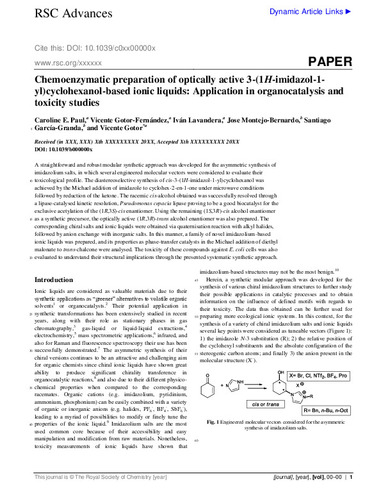Chemoenzymatic preparation of optically active 3-(1H-imidazol-1-yl)cyclohexanol-based ionic liquids: application in organocatalysis and toxicity studies
Fecha de publicación:
Versión del editor:
Citación:
Descripción física:
Resumen:
A straightforward and robust modular synthetic approach was developed for the asymmetric synthesis of imidazolium salts, in which several engineered molecular vectors were considered to evaluate their toxicological profile. The diastereoselective synthesis of cis-3-(1H-imidazol-1-yl)cyclohexanol was achieved by the Michael addition of imidazole to cyclohex-2-en-1-one under microwave conditions followed by reduction of the ketone. The racemic cis-alcohol obtained was successfully resolved through a lipase-catalysed kinetic resolution, Pseudomonas cepacia lipase proved to be a good biocatalyst for the exclusive acetylation of the (1R,3S)-cis enantiomer. Using the remaining (1S,3R)-cis alcohol enantiomer as a synthetic precursor, the optically active (1R,3R)-trans alcohol enantiomer was also prepared. The corresponding chiral salts and ionic liquids were obtained via quaternisation with alkyl halides, followed by anion exchange with inorganic salts. In this manner, a family of novel imidazolium-based ionic liquids was prepared, and their properties as phase-transfer catalysts in the Michael addition of diethyl malonate to trans-chalcone were analysed. The toxicity of these compounds against E. coli cells was also evaluated to understand their structural implications through the presented systematic synthetic approach.
A straightforward and robust modular synthetic approach was developed for the asymmetric synthesis of imidazolium salts, in which several engineered molecular vectors were considered to evaluate their toxicological profile. The diastereoselective synthesis of cis-3-(1H-imidazol-1-yl)cyclohexanol was achieved by the Michael addition of imidazole to cyclohex-2-en-1-one under microwave conditions followed by reduction of the ketone. The racemic cis-alcohol obtained was successfully resolved through a lipase-catalysed kinetic resolution, Pseudomonas cepacia lipase proved to be a good biocatalyst for the exclusive acetylation of the (1R,3S)-cis enantiomer. Using the remaining (1S,3R)-cis alcohol enantiomer as a synthetic precursor, the optically active (1R,3R)-trans alcohol enantiomer was also prepared. The corresponding chiral salts and ionic liquids were obtained via quaternisation with alkyl halides, followed by anion exchange with inorganic salts. In this manner, a family of novel imidazolium-based ionic liquids was prepared, and their properties as phase-transfer catalysts in the Michael addition of diethyl malonate to trans-chalcone were analysed. The toxicity of these compounds against E. coli cells was also evaluated to understand their structural implications through the presented systematic synthetic approach.
ISSN:
DOI:
Patrocinado por:
This project was supported by the BIOTRAINS Marie Curie Initial Training Network, financed by the European Union through the 7th Framework People Programme (grant agreement number 238531). Financial support from the Spanish MICINN (Projects CTQ-2007-61126, MAT-2006-01997 and MAT-2010-15094) is also gratefully acknowledged. V. G. -F. and I. L. acknowledge MICINN for their research contracts under the Ramo´n y Cajal Program
Colecciones
- Artículos [37556]
- Investigaciones y Documentos OpenAIRE [8424]
- Química Orgánica e Inorgánica [518]
Ficheros en el ítem





